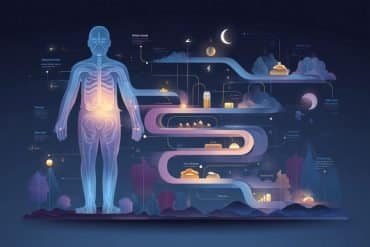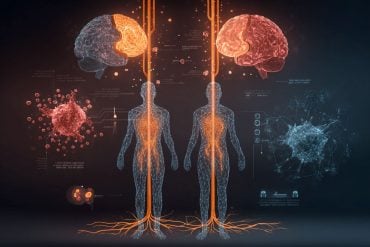Summary: Decision-making requires two different brain areas that mature at different times during the teenage years. This may help parents understand why their teens are more prone to making risky decisions.
Source: The Conversation
It’s not easy being a teenager. Once adolescence arrives, navigating new skills such as managing emotions, gaining more independence from parents and the responsibility of decisions make it a challenging time.
Boys and girls will experiment, take risks, make mistakes and eventually become adults. And when we think of adolescence, some of the issues that come to mind are drinking, mood swings, abuse of digital technologies and social networks, first sexual relations, drugs, unwanted pregnancies, fights.
It is a complicated stage in life that once we are adults we struggle to remember and often don’t understand.
For adults that live or work with teenagers there is also a challenge. But understanding how teenagers see the world or what makes them behave in a certain way is important. And part of this is understanding the development cues that help them to define their personal and sexual identity, and learn how to be part of a peer group – disengaging emotionally from parents to let friends start to meet their emotional needs more.
Pleasure seeking
Scientific advances in neuroscience help us understand how adolescents carry out the decision-making process. Perhaps the most significant finding is that they do so with a brain that is still developing, so not all of its competencies are fully acquired. And this can lead to mistakes.
During adolescence, there are many situations that require making decisions: trying something new, approaching another person we find attractive or transgressing a rule established by the family. All these decisions involve two areas of the brain that mature at very different times.
The mesolimbic system that is responsible for, among other things, regulating our body’s reward system. This system reinforces the repetition of behaviours that create pleasure – such as partying with friends – or survival behaviours – such as drinking water from time to time or on very hot days. Activation of the mesolimbic system is partly mediated by hormone production. This is why during adolescence its activation is very high.
The prefrontal cortex is also a key area of the brain at this time, which is responsible for executive functions such as impulse regulation and self-control. One of its functions is to assess the consequences of a behaviour. The prefrontal cortex, however, is in development during our adolescent years. This means there is a maturity deficit in the brain regions that are responsible for behavioural control.
This imbalance, which in the scientific literature is called the Dual Systems Model, is key to understanding why adolescents sometimes make the decisions they do. In their heads, a highly activated pleasure-seeking system is combined with a developing conscious behavioural regulation system.
In short, it is the perfect combination for teenagers to engage in behaviours that adults consider risky.
Feeling part of a group
In addition to individual development, the social world of adolescents is also key at this stage.
In these years, peers become a fundamental part of socialisation and learning. Boys and girls don’t disengage completely from family, but they do expand their social circle. Increasingly, they look for trust, support and security in their friends.
Adapting and adjusting one’s behaviour to be part of, and feel integrated into, that group becomes a priority. And group norms will, to a large extent, regulate individual behaviour. What others see as positive and accepted will be desired and repeated. What is censored or seen as negative will be repressed.
In this way, developing teenagers will try to conform to what they assume the group expects of them while facing elements such as peer pressure – that is, the influence that the social group is able to exert on a person – or even “imaginary hearing”, a characteristic of adolescent cognitive development that makes them think that others are always looking at them, assessing and judging their actions.
The role of adults
Adolescent development is a complex process with very particular characteristics. They cannot yet be considered as adults, but childish behaviours are also being left far behind. Risk-taking has been, and still is, characteristic of adolescence.

However, this stage does not have to be stormy, neither for them nor for the adults in their life, if we understand what is happening and why they act in this particular way. And managing difficult situations is also easier if we can give them specific tools and support. Here are three tips from scientific studies:
- Making mistakes and taking certain risks is an adolescent process: the important thing is to learn from them.
- The brain development of this age group means that the pleasure of experimenting with certain risky behaviours prevents a proper assessment of their consequences. It is necessary to explain, carefully and with understanding, what these consequences are.
- Adolescents need to feel free to experiment and make mistakes, but they also need to know the limits and consequences. Although they want to be independent, they still need to feel cared for by the adults.
The adolescent perspective is very different from the adult perspective. Understanding their point of view and valuing it as such is fundamental. They need to feel listened to and, above all, understood, while they navigate what can be a difficult time.
Funding:
Carmen Viejo receives funding from the Andalusia FEDER Operational Programme 2014-2020 (project: Psycho-evolutionary and Educational Process of Adolescent Courtship: Sentimental Competence and Social Adjustment, UCO-1380774) and from the Spanish Ministry of Science and Innovation, call for R+D+i 2020 projects (project: Challenges and risks in adolescent erotic-sentimental experiences: the multidimensionality of Sentimental Competence in the framework of Courtship, PID2020-119855RA-I00).
Noemí Toledano Fernández receives funding from the Andalusia FEDER Operational Programme 2014-2020 (project: Psycho-evolutionary and Educational Process of Adolescent Courtship: Sentimental Competence and Social Adjustment, UCO-1380774) and from the Spanish Ministry of Science and Innovation, call for R+D+i 2020 projects (project: Challenges and risks in adolescent erotic-sentimental experiences: the multidimensionality of Sentimental Competence in the framework of Courtship, PID2020-119855RA-I00).
About this neurodevelopment and risk-taking research news
Author: Carmen Viejo and Noemí Toledano Fernández
Source: The Conversation
Contact: Carmen Viejo and Noemí Toledano Fernández – The Conversation
Image: The image is in the public domain






